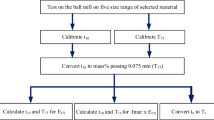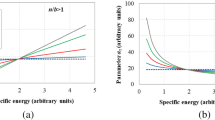Abstract
The entropy model based on population balance enables theoretical prediction of particle size distribution of comminution product. Selection and breakage functions occur in this model. The form of the selection function was determined experimentally. Informational entropy was used for the breakage function determination. Parameters of both functions can be estimated from experiments. The parameter identification of the entropy model was carried out on the basis of research on limestone comminution. Grinding tests were carried out in a laboratory fluidised bed jet mill. The results of the experimental identification confirm the accuracy of the entropy model.
Similar content being viewed by others
Abbreviations
- a :
-
parameter of selection function
- b ij :
-
breakage function
- c K :
-
constant factor of Kick’s hypothesis (J/kg)
- c R :
-
constant factor of Rittinger’s hypothesis (J m/kg)
- e ij :
-
density of used energy (J/kg)
- f p i :
-
particle size distribution of product
- f s j :
-
particle size distribution of feed
- Fp (x ):
-
cumulative particle size distribution of product
- Fs (x ):
-
cumulative particle size distribution of feed
- i :
-
size class number of product
- j :
-
size class number of feed
- m :
-
number of size classes
- p ij :
-
transition function
- S j :
-
selection function
- x :
-
particle size (μm)
- x i :
-
arithmetic mean of size limits of i th class of product (μm)
- y j :
-
arithmetic mean of size limits of j thclass of feed (μm)
- α:
-
parameter of power form of selection function
- λ:
-
Lagrange multiplier (kg/J)
References
Austin L.G. (2004). A preliminary simulation model for fine grinding in high speed hammer mills. Powder Technol. 143–144: 240–252
Bass L. (1954). Zur Theorie der Mahlvorgänge. Z. Angew. Math. Physik 5: 283–292
Berthiaux H., Marikh K., Mizonov V., Ponomarev D. and E. Barantzeva(2004). Modeling continuous powder mixing by means of the theory of Markov chains. Part Sci. Technol. 22: 379–389
Berthiaux H., Mizonov V. and Zhukov V. (2005). Application of the theory of Markov chains to model different processes in particle technology. Powder Technol. 157: 128–137
Berthiaux H. and Mizonov V. (2004). Applications of Markov chains in particulate process engineering: a review. Can. J. Chem. Eng. 82: 1143–1168
Bertrand D., Guibert D., Melcion J.-P. and Duc G. (1999). Evaluation of the transition matrix for comminuting pea seeds in an impact mill using a linear neural network. Powder Technol. 105: 119–124
Bilgili E. and Scarlett B. (2005). Population balance modeling of non-linear effect in milling processes. Powder Technol. 153: 59–71
Bilgili E., Yepes J. and Scarlett B. (2006). Formulation of a non-linear framework for population balance modeling of batch grinding: Beyond first-order kinetics. Chem. Eng. Sci. 61: 33–44
Brandt, S.: Data analysis (in Polish). WN PWN, Warsaw (2002)
Broadbent S.R. and Callcott T.G. (1956). A matrix analysis of processes involving particle assemblies. Philos. Trans. R. Soc. Lond. A 249: 99–123
Broadbent S.R. and Callcott T.G. (1956). I. A new analysis of coal breakage processes. II. A matrix representation of breakage. J. Inst. Fuel 65: 524–539
Chapelle P., Abou-Chakra H., Christakis N., Patel M., Abu-Nahar A., Tüzün U. and Cross M. (2004). Computational model for prediction of particle degradation during dilute-phase pneumatic conveying: The use of a laboratory-scale degradation tester for the determination of degradation propensity. Adv. Powder Technol. 15: 13–29
Cho H. and Austin L.G. (2003). An equation for the breakage of particles under impact. Powder Technol. 132: 161–166
Clerc L., Ouammou M. and Benhassaine A. (1996). Dimensioning a forced movement wet grinder with a Mac Cabe and Thiele construction. Int. J. Miner. Process. 44(45): 663–672
Diemer, R.B., Olson, J.H.: A moment methodology for coagulation and breakage problems: Part 1–3 – generalized daughter distribution functions. Chem. Eng. Sci. 57, 2193–2209, 2211–2228, 4187–4198 (2002)
Diemer R.B. and Olson J.H. (2006). Bivariate moment methods for simultaneous coagulation, coalescence and breakup. J. Aerosol Sci. 37: 363–385
Eskin D. and Voropayev S. (2001). Engineering estimations of opposed jet milling efficiency. Miner. Eng. 14: 1161–1175
Gardner, R.P., Austin, L.G.: A chemical engineering treatment of batch grinding. In: 1st Proc. European Symposium on Size Reduction, Verlag Chemie, Düsseldorf, pp 217–248 (1962)
Hukki R.T. (1961). Proposal for a solomonic settlement between the theories of von Rittinger, Kick and Bond. Trans. AIME 220: 403–408
Kostoglou M. and Karabelas A.J. (2002). An assessment of flow-order methods for solving the breakage equation. Powder Technol. 127: 116–127
Kostoglou M. and Karabelas A.J. (2005). On the self-similar solution of fragmentation equation: Numerical evaluation with implications for the inverse problem. J. Colloid Interface Sci. 284: 571–581
Kostoglou M. and Karabelas A.J. (2005). Toward a unified framework for the derivation of breakage functions based on the statistical theory of turbulence. Chem. Eng. Sci. 60: 6584–6595
Marikh K., Berthiaux H., Mizonov V., Barantseva E. and Ponomarev D. (2006). Flow analysis and Markov chain modelling to quantify the agitation effect in a continuous powder mixer. Chem. Eng. Res. Des. 84: 1059–1074
Mizonov V., Zhukov V., Korovkin A. and Berthiaux H. (2005). On possible instability of throughputs in complex milling circuits. Chem. Eng. Process. 44: 267–272
Mizonov V.E., Berthiaux H., Zhukov V.P. and Bernotat S. (2004). Application of multi-dimensional Markov chains to model kinetics of grinding with internal classification. Int. J. Miner. Process. 74: S307–S315
Mizonov V.E., Zhukov V.P. and Bernotat S. (1997). Simulation of grinding: new approaches. ISPEU Press, Ivanovo
Morrell S. (2004). An alternative energy–size relationship to that proposed by Bond for the design and optimisation of grinding circuits. Int. J. Miner. Process 74: 133–141
Nowak, R.: Statistics for physicists (in Polish). WN PWN, Warsaw (2002)
Otwinowski H. (2006). Energy and population balances in comminution process modeling based on the informational entropy. Powder Technol. 167: 33–44
Otwinowski, H.: Informational entropy in the modelling of comminution process (in Polish). University of Mining and Metallurgy Press, Cracow, 124 (2003)
Otwinowski H. (2006). Maximum entropy method in comminution modeling. Granular Matt. 8: 239–249
Ramkrishna D. (2000). Population balances—theory and applications to particulate systems in engineering. Academic, San Diego
Rumpf H. (1973). Physical aspects of comminution and new formulation of a law of comminution. Powder Technol. 7: 145–159
Sedlatschek K. and Bass L. (1953). Contribution to the theory of milling processes. Powder Metal Bull. 6: 148–153
Soos M., Sefcik J. and Morbidelli M. (2006). Investigation of aggregation, breakage and restructuring kinetics of colloidal dispersions in turbulent flows by population balance modeling and static light scattering. Chem. Eng. Sci. 61: 2349–2363
Stamboliadis E.Th. (2002). A contribution to the relationship of energy and particle size in the comminution of brittle particulate materials. Miner. Eng. 15: 707–713
Zhukov V.P., Mizonov V.E., Filitchev P.V. and Bernotat S. (1998). Application of the principle of entropy maximum to predicting the performance of comminution processes. Theor. Found Chem. Eng. 32: 159–162
Zhukov V.P., Mizonov V.E., Filitchev P.V. and Bernotat S. (1998). The modelling of grinding processes by means of the principle of maximum entropy. Powder Technol. 95: 248–253
Zhukov, V.P., Mizonov, V.E., Otwinowski, H.: Entropy approach of comminution kinetics (in Russian). International Conference “Theoretical and experimental basis of new devices design”. Ivanovo-Ples (1993)
Author information
Authors and Affiliations
Corresponding author
Rights and permissions
About this article
Cite this article
Otwinowski, H., Zbroński, D. & Urbaniak, D. Experimental identification of entropy model of comminution process. Granular Matter 9, 377–386 (2007). https://doi.org/10.1007/s10035-007-0049-z
Received:
Published:
Issue Date:
DOI: https://doi.org/10.1007/s10035-007-0049-z




